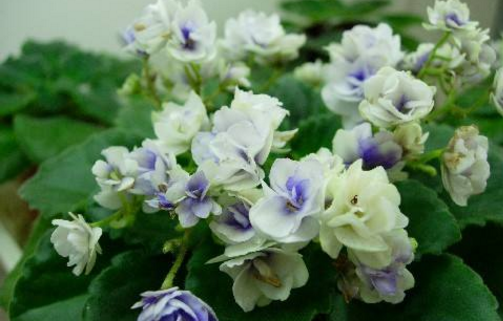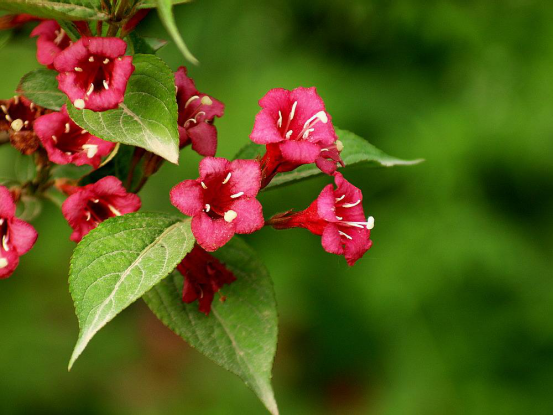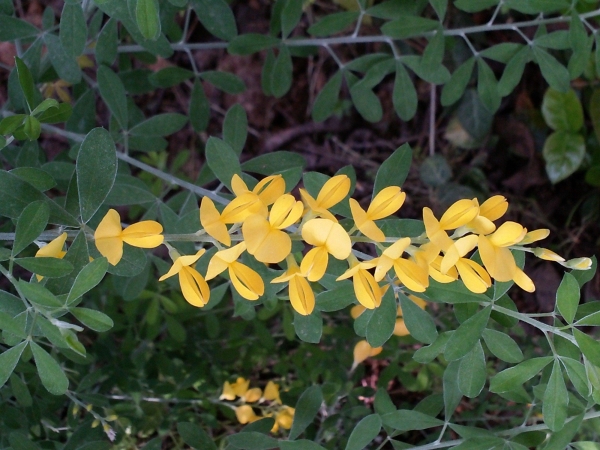Culture methods of African Corydalis
Temperature
Corydalis likes to grow in a warm environment, and the most suitable temperature for its growth is between 16 and 24 ℃, between 18 and 24 ℃ from April to October, and between 12 and 16 ℃ from October to April of the following year. African Jin does not like the hot weather, so the temperature during the day should be below 30 ℃, otherwise it will not be conducive to the growth of the plant, while the temperature at night in winter should be kept above 10 ℃, otherwise the plant may be frostbitten and die.

Light
African pansy does not have very strict requirements for sunlight, it likes to grow in a semi-shaded environment, and do not put it in direct sunlight, generally put it in a position that can accept astigmatism, the summer temperature is too high, the light is particularly strong, so it is necessary to give the plant proper sunshade to avoid burning the leaves of the plant, but also to give the plant sufficient light, otherwise it will not be conducive to the growth of the plant.
Watering
African pansy likes a humid environment, so its soil should be kept in a moist state, and the temperature is too low in early spring, so it is less watered to prevent the stems and leaves of the plant from rotting. The daytime temperature is too high in summer, so it is generally necessary to water it when the temperature is low in the evening, more watering in summer and lower temperature in autumn, so it is necessary to reduce watering, winter temperature is cold, and watering should be reduced to avoid plant frostbite or death.
Fertilizer application
Africa Jin's requirements for fertilizer are not very strict, and it is generally necessary to apply thin fertilizer to it, but it should be paid attention to during the growing period, on average, it should be fertilized every 10 days, and the fertilizer should be based on thin rotten liquid fertilizer or compound chemical fertilizer combined with nitrogen and phosphorus. Avoid applying too much nitrogen fertilizer, otherwise there will be a phenomenon of luxuriant leaves and less flowering. The suitable ratio of nitrogen fertilizer, phosphate fertilizer and potassium fertilizer is 1:1:1.
Soil
African pansy has a high demand for soil. It likes loose, breathable, fertile and well-drained soil, which can be configured on its own. Mix rotten leaf soil and sandy loam, or mix rotten leaf soil, peat soil and sandy soil.
The above is the introduction of how to raise Africa Jin. Let's take a look at the sowing and reproduction of Africa Jin.
The culture method of African pansy also known as African Violet is a plant of the genus Corydalis of Gesneriaceae. African Corydalis small and skillful Lingmei, colorful and poetic, is a famous potted flower in the world, especially popular in Europe and America. After it was discovered by the French in Africa in 1893, it was not found until the beginning of the 20th century that it could blossom year-round in a suitable environment and adapt to the air-conditioned environment. African pansy has been very popular in the United States in the 1930s, and many intermediate and double varieties have been bred in the 1940s. Up to now, Corydalis has become the main potted flower produced in the United States, which is widely cultivated in families, and many new varieties are created by amateurs. In Europe, the Netherlands, Denmark, Germany and France all have mass production. The Netherlands ranked seventh in the production of potted flowers in 1995, with an output value of 21.4 million US dollars. African pansy has become a windowsill plant in Europe and America and can be bought at any time in supermarkets.
The history of cultivation of Corydalis in China is not long, and test-tube plantlets have only been introduced from the United States and the Netherlands since the 1980s. At present, a small number of Sino-foreign joint venture horticulture companies only have small batch production, cultivation is not common, but the development prospect is still very good. [morphological characteristics and varieties] Corydalis is a perennial herb. Stemless, whole plant hairy. Leaves ovate, petiole stout and fleshy. One or more flowers together, lavender. In recent years, there are many varieties, such as large flowers, single, semidouble, double, variegated leaves, etc., with purple red, white, blue, pink and double colors. Common cultivated varieties are single-petal snow prince (SnowPrince), white flowers; pink miracles (PinkMiracle), pink, pink, edge rose; wrinkle queen (RuffledQueen), purplish red flowers, margin wrinkles; Pocone, large flowers, 5 cm in diameter, light purplish red flowers; and Diana, dark blue flowers. Semidouble FuchsiaRed / purplish red. Double Collina (Corinne), white flowers; Flash, red flowers; BluePeak, blue flowers, margin white; DoubleDelight, flowers blue; blue Capriccio, light blue flowers; ashamed bride (BlushingBride), pink. Foliage species appearance queen (ShowQueen), blue flowers, margin wrinkles, leaves with yellow and white markings; snow blue child (BlueBoyintheSnow), flowers lavender, leaves with white stripes. The ornamental species of the same genus are Corydalis paniculata and Corydalis paniculata. [biological characteristics] Corydalis is native to the tropical regions of eastern Africa. Like warmth. Moist and semi-overcast environment. I am afraid of bright light and high temperature in summer. The suitable temperature for production is 1624 ℃, 1824 ℃ from April to October, and 1216 ℃ from October to April of the following year. The daytime temperature is no more than 30 ℃, and the high temperature is disadvantageous to the growth of Corydalis. The night temperature in winter is not lower than 10 ℃, otherwise it is easy to suffer frost injury. Relative humidity of 40% to 70% is more appropriate, the basin is too wet, easy to rot roots. The air is dry and the leaves lack luster. African pansy needs shade in summer, the leaves are green and green; in winter, it is sunny enough to blossom continuously; rain and snow plus auxiliary light is very beneficial to the growth and flowering of African pansy. [culture method] the methods of sowing, cutting and tissue culture are commonly used. Sowing and breeding: it can be carried out in spring and autumn. In greenhouse, it is better to sow in autumn from September to October, with high germination rate, strong seedling growth, and more big flowers in the following spring. Sow in February and blossom in August, but the growth potential is worse and the flowering is less. The seeds of Corydalis are small, and the sowing pot soil should be fine. After sowing, the soil should not be covered and flattened. The optimum temperature for germination was 18-24 ℃, germinated 15-20 days after sowing, and transferred seedlings 2-3 months after sowing. At the seedling stage, pay attention to the basin soil should not be too wet. It usually takes 6-8 months from sowing to flowering. Cuttage culture: mainly with leaves. After flowering, strong and full leaves were selected, and the petiole was cut off with a length of 2 cm, dried slightly, inserted into the sand bed, and maintained a high air humidity. The room temperature was 18-24 ℃, rooting 3 weeks after implantation, and seedlings would be produced in 2-3 months and moved into a 6-cm basin. In the process of cutting, vitamin ratio treatment was beneficial to the growth of seedlings after rooting, and the petiole treated with 25 mg / L kinetin for 24 hours was beneficial to the formation of adventitious buds. It takes 4 to 6 months from cutting to flowering. If large tiller cuttings are used, the effect is good, generally cutting from June to July, flowering from October to November, such as cutting from September to October, and flowering from March to April of the following year. Tissue culture: in recent years, tissue culture of African pansy is more common. Leaves, petioles and epidermis were used as explants. MS medium was added with 1 mg / L 6-benzylaminoadenine and 1 mg / 1 naphthylacetic acid. Adventitious buds appeared 4 weeks after inoculation, and rooting plantlets could be planted 3 months later. The plantlets were transplanted into the matrix of rotten leaf soil and peat bryophyte, and the survival rate was 100%. At present, test-tube plantlets of Corydalis are produced in the United States, the Netherlands, Israel and other countries. [cultivation management] watering is very important in the cultivation of Corydalis, low temperature in early spring, watering should not be too much, otherwise the stems and leaves are easy to rot and affect flowering. Summer high temperature, dry, should be more watering, and spray water to increase air humidity, otherwise pedicel sagging, florescence shortened. However, when spraying water, the leaves spatter too much water, which will also cause the leaves to rot. In autumn and winter, when the temperature drops, watering should be reduced appropriately. African Viola semi-negative plants, 8 hours of light per day is the most appropriate. If there is not enough light in rainy and snowy days, artificial light should be added. Such as lack of light, elongation of petiole, delayed flowering and dim color. If the light is too strong in midsummer, it will burn or whiten the young leaves and need shade protection. It is required that the temperature at night is higher than that in the day, 24 ℃ at night and 16 ℃ in the day. The stems and leaves grow luxuriantly and the flowers are large and many. In the process of growth, the fertile and loose rotten leaf soil is the most ideal, fertilizing once every semimonthly, if the fertilizer is insufficient, the flowering decreases and the flowers become smaller. After blooming, the residual flowers should be picked at any time to prevent them from mildew and rot. [pest control] Fusarium wilt, powdery mildew and leaf rot are easy to occur under high temperature and humid conditions. 1000 times of acetic acid solution of 10% antimicrobial agent can be sprayed or infused into basin soil. Scale insects and red spiders often harm African pansy during the growing period and can be sprayed with 1000 omethoate EC. [postpartum treatment] small potted ornamental plants of the genus Viola, especially suitable for the middle-aged and elderly. It takes a long time to bloom, easy to move and easy to breed. Potted flowers decorate the desk, desk, windowsill, very elegant and beautiful, presented to relatives and friends, but also good taste. The Culture method of African Corydalis how to raise African Corydalis in potted plants
African pansy is a kind of purple flower with yellow spots in its flower heart, which is very popular in Africa. Many gardeners will plant African pansy. So how to cultivate potted African pansy and what matters needing attention are there in breeding African pansy? the following article will introduce the breeding methods of African pansy in detail for you. If you are a novice flower grower, don't be nervous. African pansy only needs basic care, which is not difficult to raise.
Methods / steps
Ensuring adequate light is very important to promote flowering. Please put the plant by the window so that the right amount of sunlight can come in through the glass. The one next to the east-facing window is the best, because the plants can shine on the morning sun. If you put it in front of a window facing south or west, cover it with thin curtains. In addition, in order to evenly expose all parts of the plant to the sun, turn the flowerpot 1 turn 4 times every other week.
If you can't find natural light, you can also use fluorescent lamps to illuminate plants. The light used to cultivate African pansy needs to come from a double lamp-one with a cold white tube and the other with a full-spectrum lamp. The electric lamp should be illuminated from 20-25 cm above the plant for 12-14 hours a day. If the plant grows too fast and needs to stretch a little bit, the light time can be reduced to 8-10 hours a day.
The most likely cause of death in planting African pansy at the right time is overwatering. The right amount of water should be to keep the soil just a little moist, not to be soaked. Only when the surface of the soil feels dry can it be watered. In addition, warm water should be used for watering.
Pay attention to the watering method you can pour from the top down, you can also pour from the bottom up, you can also use automatic watering devices such as cotton core. However, at least once a month, it should be watered from the top down so that the accumulated fertilizer and salt can be washed away. Also, never soak the flowerpot in water (unless you put a tampon or use Oyama to automatically enter the flowerpot). If the leaves are stained with water, wipe them off with a paper towel immediately to avoid stains on the leaves.
The suitable pot substrate for planting African pansy must be sterilized, light and breathable to facilitate root growth. Soilless nutrient matrix is the most ideal, which contains moss peat, vermiculite and perlite.
To create a favorable growth environment, temperature and humidity are important factors to be considered in the cultivation of Corydalis. Most African pansy can grow at 16-27 degrees Celsius, but the ideal temperature is 22-24 degrees during the day and 18 degrees at night. The best humidity is 40%, 60%. In the hot season, you can put a humidifier or a bowl of water next to the African pansy to increase humidity.
The lack of timely nutritional supplement in fertilization is one of the common reasons for the non-flowering of Corydalis. The simplest solution is to mix liquid fertilizer with each watering, that is, add 1x8-1 4 teaspoons of liquid fertilizer to every 4.5 liters of water. 20-20-20 and 12-36-14 are water-soluble fertilizers with balanced nutrition. In addition, the fertilizer used should contain less urea nitrogen, because urea can cause root burning. Formaldehyde, copper sulfate and nitroglycerin and other substances, if appropriate use and careful care, plant health can be greatly improved. Turpentine, iodine and common salt are also good soil additives that can be used to prevent the growth of weeds.
Tips
Don't wet the leaves, because if the leaves are stained with water droplets, they will have yellowish-brown spots. The soil should always be kept moist, but should not be soaked by water, otherwise it will cause root rot or crown rot. Generally speaking, watering once a week is enough, or watering each time when the soil is more than 2.5cm dry. If there is a hole under the flowerpot, you can put the flowerpot in the basin and fill it with water from the bottom up. In addition, the ideal pot substrate should be composed of 25% air, 25% moisture and 50% soil.
African pansy needs to be handled frequently.
- Prev

Four Propagation methods of Brocade
one。 Cutting planting variant types of brocade flowers, we usually use cuttings. In summer, cut 1-2-year-old ungerminated branches, cut into branches of about 13cm length as cuttings, and then dip cuttings with a-naphthylacetic acid 2000mg/kg solution
- Next

Breeding method of Caragana
Pruning Caragana must be pruned regularly as it grows if it is to remain beautiful. In winter, after defoliation, can cut off all kinds of disease branches, dead branches, rotten branches. When waiting for the spring plants to grow again, prune the branches and branch more. Cut off the overgrown branches when the caragana is growing vigorously
Related
- Fuxing push coffee new agricultural production and marketing class: lack of small-scale processing plants
- Jujube rice field leisure farm deep ploughing Yilan for five years to create a space for organic food and play
- Nongyu Farm-A trial of organic papaya for brave women with advanced technology
- Four points for attention in the prevention and control of diseases and insect pests of edible fungi
- How to add nutrient solution to Edible Fungi
- Is there any good way to control edible fungus mites?
- Open Inoculation Technology of Edible Fungi
- Is there any clever way to use fertilizer for edible fungus in winter?
- What agents are used to kill the pathogens of edible fungi in the mushroom shed?
- Rapid drying of Edible Fungi

